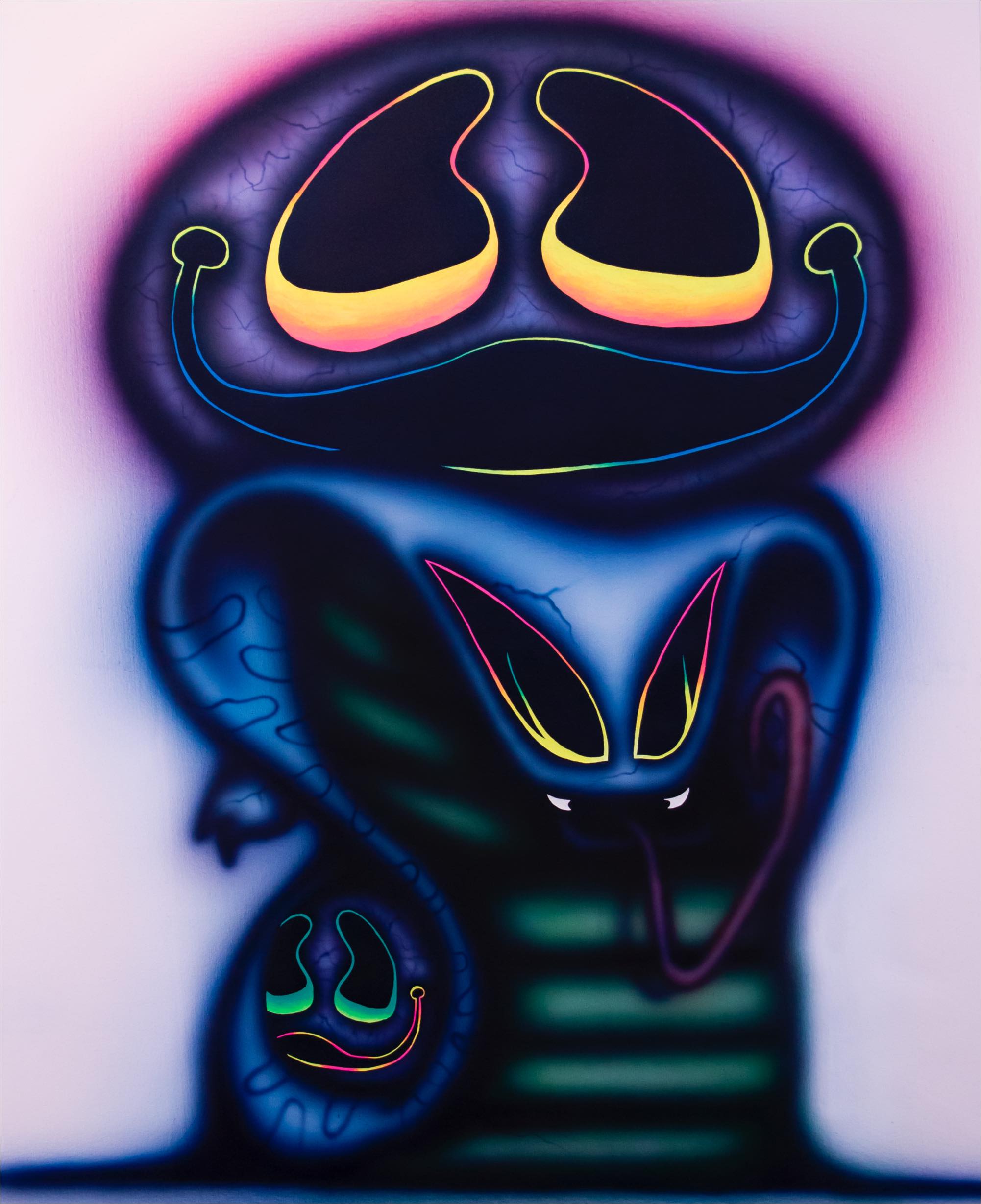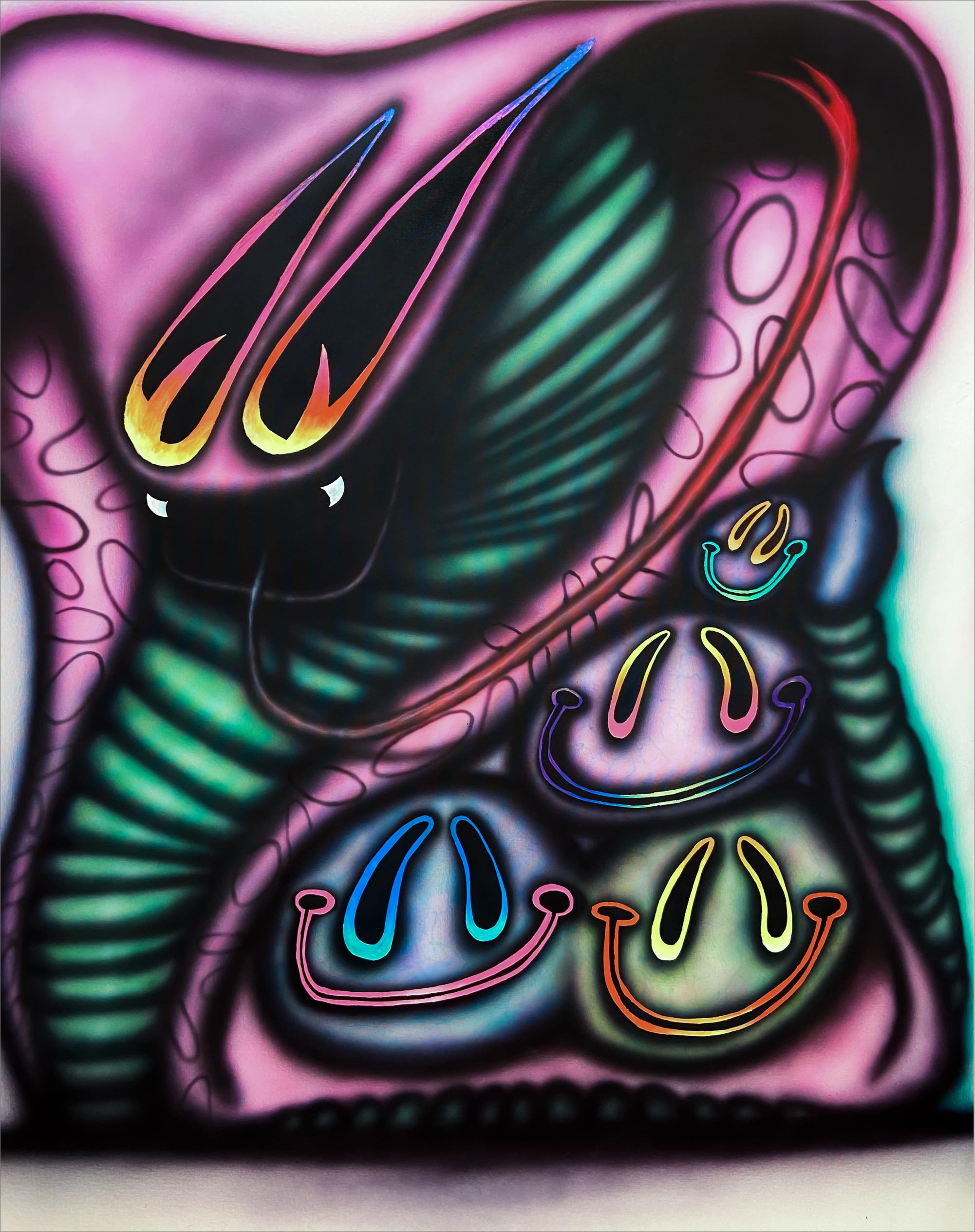Carnival
Erik Foss
April 8 –April 28, 2023
GALLERY HOURS :11:00 – 19:00
GALLERY CLOSED:
SUNDAY, MONDAY, PUBLIC HOLIDAYS
Opening Reception:
18:00〜20:00 April 8, 2023

Kaikai Kiki Gallery is pleased to present “Carnival,” the first solo exhibition of Erik Foss’s works in Japan opening on April 8, 2023.
Erik Foss is an artist based in New York. Born in Illinois and raised in Phoenix, Arizona, Foss became an artist without attending art school. Snakes painted in neon colors that frequently appear in his works are icons of the American lowbrow culture of the ’80s that Foss himself has experienced. This is the first solo exhibition in Japan for the artist, who has mainly exhibited in the USA thus far. The exhibition will feature new paintings and drawings that have been in the works for more than six months. We look forward to your visits.

Gotham, Water-based paint and solid paint marker on canvas, 2590x2235mm ©Erik Foss
The Snake Charmer – Carlo McCormick
Erik Foss is from the desert: as a geographical fact the Sonoran Desert, as a social reality a trailer park on the outskirts of Phoenix, Arizona where poverty, disenfranchisement, prejudice and ignorance sever people from fabric of cultural expression and appreciation that many denizens of city-life call the arts. This is not unique to his background, large swaths of America and the whole world for that matter live in cultural deserts where that acquired taste for opera, ballet, fine art, literature and the like are simply not part of their diet. This is not to say there are no libraries, concert halls, museums and galleries outside the big city cultural capitals, just to note that their function has been diminished and demeaned for the majority, made precious and specialized for the elite. This has a lot to do with class, that shorthand qualifier we use to denote a whole range of socio-economic disparities too entrenched and systemic for us to untangle their myriad and nuanced effects. However, as with all things that insinuate themselves generationally into the body politic, it also has a great deal to do with identity.
Cultural identity is crucial to the imagery of Erik Foss’ recent body of paintings; prominently featuring snakes but frequently adorned with the easy symbols of pop culture detritus like smiley faces, with a rainbow here or a landscape there. This stuff, tacky kitsch and quotidian embellishments all, is his way of saying who he is, of telling us where he comes from. It’s remarkable for an artist who has lived nearly thirty years in New York City, who has made things adjacent to what we think of as urban art without ever falling for its most common clichés, to return to his rootless roots not as a quest for personal transformation so much as an investigation into the personal meaning of the mundane. Erik Foss is not painting the desert sublime in the tradition of American artists like Georgia O’Keefe and those rugged Wild West storytellers like Frederic Remington and C.M. Russell, or the colonialist Oriental exotica of painters ranging from Jean-Leon Gerome to even those known for other genres like Frederic Church and J.M.W. Turner. His is the desert you find airbrushed on the sides of vans, a wily picturesque that has nothing to do with beauty and even less to do with an exotic conjuring of simplicity. Foss’ basic language of the debased is wrapped up in a disquieting complexity, serving up the guilty pleasures of empty signifiers and easy/cheesy logo-ism like the kind of comfort food you know is patently unhealthy for mind, body and soul.
The Sonoran Desert does appear just once in one of these paintings, as a postcard pretty background that is a relative companion to another with a New York Cityscape imagined from a place he has lived in longer already than his childhood home. Yet the desert is somehow everywhere in his snake paintings not as an iconography of the land but rather as the consumer-based commercial symbolism of the youth culture that was the visual landscape of his upbringing, that lowbrow mix of hot rods, punk rock and skateboard graphics, black light posters, gang graffiti, lowriders and tattoos endemic to American youth of the post-war era. It’s funny in this way that the king cobra snake is the central motif here, because they are not at all native to the United States, but ubiquitous to the design of custom-culture. Here they reside not on the land but in the imagination.
Of course snakes are not unique to the paintings of Erik Foss, rather their psychological potency in his art is amplified by their extensive appearances and diverse meanings across the narratives of so many different peoples and ages. From the Norse we get Jorgmungandr, the serpent son of Loki who encircles the world until the twilight of the gods, Rangnarok, when he is slain by Thor while killing the god of thunder himself. The Greeks had Medusa, the most famous of the Gorgons with hair of snakes whose very gaze turned men to stone, eventually slain by Perseus with much help from Athena. The Aztecs had Quetzacoatl, god of wind and rain central to their creation myth, and the Hopi have the days-long Snake Dance ritual for rainfall and fertility of the land. Rural America, most commonly in early 20th Century Appalachia, has snake handling, a crazy kind of talking in tongues communion with god that goes at least as far back to the Gnosticism of 2nd Century Ophites, and India had a long tradition of Snake Charming that goes back to ancient Egypt and the Bible, associated with magic and healing, and a big tourist draw there until it was finally outlawed in 1972. For the Dahomey, snakes were a symbol of immortality and reincarnation for their sloughing off of their skins, and among the Jumerian they were associated with healing.
Snakes, among all the animal kingdom, could arguably be said to populate more of our myths, legends and religions than any other specie. The Hindu and Buddhist have Naga, Sanskrit for serpent, who spread his cobra hood to shelter Buddha from the storm, before Brahma eventually banished him to the underground for his dangerous ill temper. Closer to the pathology of Erik Foss’ Catholic upbringing we know Saint Patrick, a 5th Century Christian missionary drove all the snakes of Ireland into the sea, an allegory for the extermination of Paganism, and amazingly many still somehow believe the biblical story of the snake in the Garden of Eden, source of humanity’s temptation, transgression and fall from grace. As icons of popular culture more likely to be found on a poster in some kid’s bedroom, as a tattoo on someone’s arm, on the bottom of a skateboard, the front of a tee shirt or a rock album cover, or just about anywhere else than the pages of some religious scripture, Foss’ snakes embody the full spectrum of spiritual, folkloric and populist connotations, slithering between desire and dread in our imaginations, specimens of ophidiophobia and ophidiophilia like dangling metaphors on a charm bracelet, goofy signs of joy and belonging still cloaked in their imprecations of danger and implicit

Cruisin the Strip, Water-based paint and solid paint marker on canvas, 1575x1321mm ©Erik Foss
As precautionary measures to help contain the further spread of COVID-19, visitors are asked to wear masks and sanitize their hands before entering the gallery.
(Hand sanitizer is available at the entrance. Visitors without masks will be refused entry.)
Please refrain from visiting the gallery if you have any symptoms such as fever or cough.
Our staff will also adopt frequent hand sanitation and wear masks. The gallery will be routinely ventilated and high-touch areas will be regularly disinfected.
*Please check our website or Instagram for the latest information regarding opening hours, as the gallery schedule is subject to abrupt change due to unpredictable circumstances.
Thank you for your cooperation and understanding.